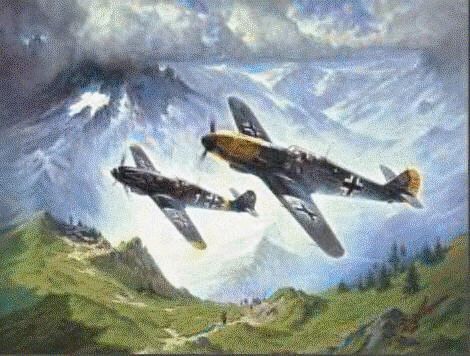Messerschmitt Bf 109

At left is the Bf109G of Erich "Bubi" Hartmann, JG 52 (Eastern Front). At right is the Bf109F of Adolf "Dolfo" Galland, JG 26 (Western Front). (Artist Unknown)
When one thinks of German air might, the Messerschmitt Bf 109* is probably the first airplane that pops into mind. In 1935 the Bf 109 was the most advanced fighter of the time. It featured stressed skin construction, a highly loaded wing with flaps and full span slats. Unfortunately, Willi Messerschmitt had fallen out of favor with the NAZI party and had difficulty winning a contract. However, greatness can't be denied and soon the 109 was at the core of the Luftwaffe inventory. Its simple construction made mass production very easy, which was only one of many deciding factors. The Berta, or B-model, was the first to see action in the Spanish Civil War and it distinguished itself in combat. By 1939 it was effectively the only fighter in the German arsenal.
At the onset of hostilities in WWII the E, or Emil, was the latest model. It incorporated direct fuel injection which eliminated fuel feed problems during high negative G maneuvers. However, at high speeds it was increasingly difficult to fly, and the flaps had a nasty habit of popping open unexpectedly. The next version, F or Franz, appeared in 1940. In this model, the armament was improved and the wing shape became more rounded. By 1942, the Luftwaffe looked for a replacement, and, when none could be found, the 109F was improved and was designated the 109G, or Gustav. The Gustav had either Methanol/Water or Nitrous Oxide injection systems to boost engine torque. The 109 was kept in production throughout the war, even when the Fw 190 appeared on the scene.
Below is a picture of Adolf Galland's Bf109. Adolf Galland would rise to become the Commander of Jagdgeschwader 26, stationed in Northern France, and the General in charge of all fighter pilots (General der Jagdflieger). The Balkan Cross is apparent on the rear fuselage. The chevron and dash forward of the cross indicate the pilot is the Geschwaderkommodore (Geschwader Commodore). Below the canopy, on the fuselage, is a picture of Mickey Mouse with cigar, axe and pistol. This emblem earned Galland's squad. the nickname "Mickey Mouse Squadron".

Artist Unknown
The Bf109 is a very capable fighter, and a difficult target to hit owing to its small size. It is among the smaller of the fighter aircraft, giving it lower drag coefficient. Its small size also translates into lower weight. With these qualities the 109 has the highest sustained climb rate of all other aircraft. This also means that in level flight it has higher acceleration and excels at the Boom and Zoom (or shoot and scoot) tactic. The injection system is also built with endurance in mind. However, its fuel capacity is only 88 gallons which limits its combat radius. The 109 has a higher ammo load than the spitfire, and is its equal in turn rate. However, it can not sustain the turn as long. Another interesting aspect of this plane's design is its vertical stabilizer. It is constructed off the centerline and has an airfoil shape. This produces a torque counteracting the torque generated by the engine. This helps the pilot keep his aircraft level.
The design did have one significant flaw. The undercarriage was narrow and the struts folded outward. The narrow undercarriage did not take up the engine torque adequately, and the outward folding struts were prone to collapsing under too much lateral stress. An unwary, or inexperienced, pilot often found himself performing a "ground loop" on take off. If the pilot did not compensate for the torque he found himself flipping over on the runway, destroying his aircraft and suffering serious injury, or death.
PLAYING POSSUM: The 109 was notorious for belching smoke when the injection system was engaged to boost engine power. The pilots learned to use this to their advantage when the situation got hot. They would kick in the injection system and split Ess. The enemy, seeing this smoking plane heading for the ground, often thought they had scored a kill and moved off in search of the next victim. The 109 pilot would then level off and escape from a lower altitude.
Bf 109F Statistics:
- Wing area: 16.2 square meters (174.38 square feet)
- Wing span: 8.84 meters (29 ft)
- Engine: DB601E (1,300 hp)
- Weight: about 6000 lbs
- Maximum Speed: 624 km/h (388 mph)
- Ceiling: 12,000 meters (39,372 ft)
- Range: 700 km (435 miles)
- Armament: 15mm or 20mm MG151 cannon and 2 7.92mm MG17 machine guns.
The nicknames Emil, Franz and Gustav are derived from the German phonetic alphabet (like our alpha baker charlie....) and correspond to the model variation letter (E, F, G).
When the 109 was first introduced it was built at the Bayerische Flugzeugwerke AG (Bavarian Aircraft Works). Thus, it was given the designation "Bf." In 1938 the factory would be renamed Messerschmitt AG and later designs would be designated "Me."
German Fighter Aircraft Markings
![]()
Copyright © 1998-2024, 486th Bomb Group Association.